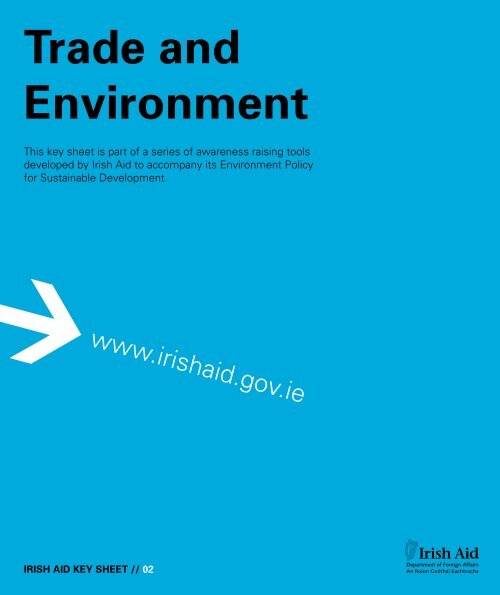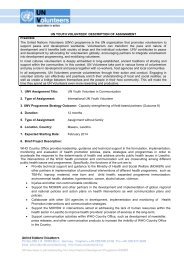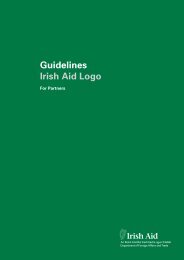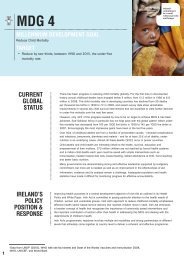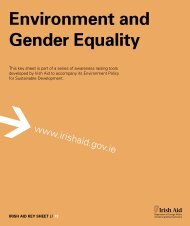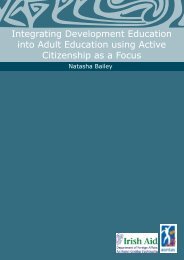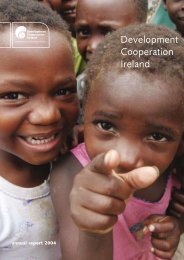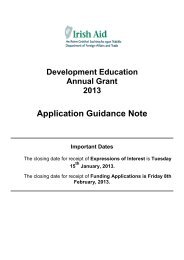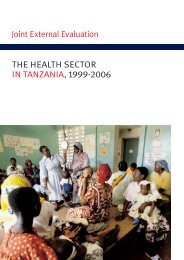Download PDF (316KB) - Irish Aid
Download PDF (316KB) - Irish Aid
Download PDF (316KB) - Irish Aid
Create successful ePaper yourself
Turn your PDF publications into a flip-book with our unique Google optimized e-Paper software.
Women selling food at the market, Accra, Ghana.
2. How are trade and theenvironment related?International trade is central to the global economy. It hasgrown by a factor of 12 since 1960 , thanks to a proliferationof multilateral, regional and bilateral trade agreements.Meanwhile, growing demand for food, water and energy haveled to radical changes to ecosystems and the degradation ofnatural resources such as forests, oil reserves, minerals andfisheries.Trade has been a significant driver of this environmentaldamage . Rising demand for palm oil has, for instance, led tovast areas of Indonesian rain forests being cleared to makeway for plantations.Yet trade itself cannot be said to be “good” or “bad” for theenvironment except on a case-by-case basis, as it can alsohave positive effects. It can create opportunities for investmentin environmental projects and can promote processes andtechnologies such as “green” packaging, organic produce,renewable energies and improved energy efficiency.The overall effect of trade on the environment will depend onthe extent to which the goals and policies for trade and theenvironment can be made mutually supportive both nationallyand internationally. Problems can arise when this coherence islacking.For instance, trade liberalisation involving a poor country mayactually lead to environmental degradation if its governmentfails to support or keep up with the liberalisation process (seeBox 1). This can effectively push smallholders off the land andthereby exacerbate poverty. 2.1 Environmental impacts of tradeTrade can:> Accelerate the use of natural resources, which in turn canincrease pressure on ecosystems (see Box 2).> Promote the transfer of environmentally friendlytechnologies, which are often lacking in developingcountries.> Affect the level of “environmental friendliness” of thetraded products: while trade in some products, such asorganic produce, may be environmentally friendly, othersproducts such as hazardous waste may be dangerous forthe environment.> Either improve environmental standards, or encouragecompanies to operate in places where more lax standardsreduce production costs.2.2 Trade, environment and developmentTrade, the environment and development are increasinglyconnected in our globalised world. Understanding how theyinteract is important in achieving sustainable development.> Industrialised countries’ demand for certain products— such as organic produce or timber from sustainablymanaged forests — creates opportunities for developingcountries to both protect their environment and providesocial benefits. For instance, Amfri Farms in Ugandaexports organic fruit and vegetables to Ireland through theTraidlinks / Heart of Africa scheme (see www.traidlinks.ie).> At the same time, some developing countries fear that richnations can use such environmental concerns to disguisetrade protectionism, which favours domestic producersover those in the South. One form this can take is “greenprotectionism”, in which an environmental pretext may beused to protect domestic trade (see Box 3). Box 1 Trade liberalisation and Mexican maize — a cautionary tale 3The North American Free Trade Agreement (NAFTA) between Canada, Mexico and the United States came into force in 1994.It immediately removed some tariffs on many products traded between the three countries and aims to remove them all by2009. While trade has increased and the poorest nation – Mexico – has benefited economically, poverty levels there remain high.In the late 1990s, Oxfam and WWF conducted a study looking at how NAFTA had affected maize production in Mexico. Whatthey found shows that trade liberalisation can lead to serious problems if state support is lacking and emerging economic,environmental and social changes are virtually ignored.Under NAFTA, Mexico’s maize production did not decline as expected, despite a sharp drop in prices and a rise in imports. In fact,although maize yields shrank, the area planted increased. Farmers had few incentives or opportunities to modernise or reallocateresources to other crops. Many small-scale farmers were forced to migrate to marginal lands, where soil erosion accelerated.State support during the transitional stage would have made a big difference. As it was, the adjustment to a more liberalagricultural regime was rushed and poorly planned. UNEP/IISD 2005 Millennium Ecosystem Assessment Board 2005 UNEP 2001 UNEP 1999
Box 4 Brazil nuts from Bolivia 7Brazil nuts are Bolivia‘s fourth biggest export, with mostbeing exported to the EU. The nut grows wild in forestsin the far north of the country where indigenous peopleharvest it by hand.European demand for the nuts therefore supports rurallivelihoods and promotes forest conservation in Bolivia.At the same time, however, strict EU regulations on foodquality make these benefits insecure.This is because Brazil nuts are prone to contaminationby aflatoxins — poisonous and carcinogenic chemicalsproduced by mould. The EU has imposed a strict maximumlevel of aflatoxins on imported goods. This could seriouslyimpede trade in the nuts.The Bolivian government and traders, with EU assistance,have considered ways around the problem. Transportationand storage facilities will need boosting. Laboratoryfacilities have been set up and accepted by the EU toallow in-country testing of products, but such facilitiesand inspections generally end up involving large costs forBolivian producers.In addition to this direct environmental impact, over fishinghas meant fewer fish for local people to eat. In Mauritaniathis has wiped out the livelihood of traditional fisher folkcalled the Imraguen, and in Ghana it has created an indirectenvironmental impact — increased demand for bushmeatoften derived from endangered wildlife . EU fish catches fromWest Africa rose 20-fold from 1950 to 2001, while subsidiesrose from US$6m in 1981 to more than US$350m in 2001.Similarly, the EU spends about half of its annual budget onsubsidies paid to European farmers under the CommonAgricultural Policy. These can distort trade and harm poorfarmers, as surplus produce can be exported to developingnations and sold more cheaply than local crops. When poorfarmers in such nations feel the squeeze and their livelihoodoptions are reduced, environmental degradation often follows.In 2005, the Commission for Africa concluded that rich-countrytrade barriers and subsidies “are absolutely unacceptable;they are politically antiquated, economically illiterate,environmentally destructive, and ethically indefensible. Theymust go.” BBC Online 2004Not all subsidies have a negative effect, however. Some canlead to environmental benefits when they are targeted toremedy the failure of markets to account for environmentalcosts of production, such as with subsidies for organic farming.4. Towards a betterintegration of trade andenvironmentNational governments need a better understanding of thecomplex relationship between trade and environment and howeach affects development.To develop the right set of supporting policies, they need toanalyse the national and international impacts of their tradepolices. The benefits of trade are not automatic, and policiesthat either increase benefits or minimise harm need to be inplace to allow the net positive contribution to be maximised.The international community can help with channelling resourcesand generating and disseminating information on the differentconnections between trade, environment and development; thevariety and effectiveness of different sets of supporting policies;and providing capacity building to national governments.<strong>Irish</strong> <strong>Aid</strong> can assist these efforts by:> Considering trade in the context of both environment andhuman development> Analysing local aspects of trade, environment anddevelopment to illuminate the connections between them> Supporting capacity building in research on internationaltrade rules> Disseminating information on links between trade and theenvironment to policymakers> Supporting the participation of developing countries ininternational trade negotiations> Boosting the importance of valuing natural resources– which could generate sustainable trade in goods andservices they provide> Promoting trade in environmentally sound goods andtechnologies> Promoting a pan-governmental approach to trade andenvironment through tapping into the experienceand resources of relevant departments, and ensuringcoherence in environment, trade and development policyusing the Inter-Departmental Development Committee asa forum.
ReferencesPrinted on Era Silk recycled paper,made from 50% genuine recovered paper wasteand 50% virgin fibre from well-managed forests.BBC Online (2004) Fisheries link to bushmeat trade. See http://news.bbc.co.uk/1/hi/sci/tech/4003859.stmEsty, D. (2001) Bridging the trade-environment divide. Journal of Economic Perspectives 15(3), 113-130.Fisheries Centre (2006) Catching More Bait: A Bottom-up Re-estimation of Global Fisheries Subsidies. Fisheries Centre ResearchReports, 14(6), Fisheries Centre, University of British Columbia, Canada.Gallagher, K. and J. Werksman (2002) The Earthscan Reader on International trade and Sustainable Development. EarthscanPublications Ltd, London.Grossman, G. and A. Krueger (1995) Economic growth and the environment. Quarterly Journal of Economics CX:0, 353-377.Henson, S., R. Loader, A. Swinbank and M. Bredhal (1999) The Impact of Sanitary and Phytosanitary Measures on DevelopingCountry Exports of Agricultural and Food Products. World Bank and World Trade Organization, Geneva.MacGregor, J. and B. Vorley (2006) “Fair Miles”? The concept of food miles through a sustainable development lens. SustainableDevelopment Opinion. IIED, London. www.iied.org/pubs/pdf/full/11064IIED.pdfMillennium Ecosystem Assessment Board (2005) Living Beyond Our Means: Natural Assets and Human Well-Being. MEAB.OECD (1994) Methodologies for Environment and Trade Reviews. OECD/GD(94)103. OECD, Paris.Oxfam (2002) Cultivating Poverty — The Impact of US Cotton Subsidies on Africa. Oxfam Briefing Paper 30. Oxfam International.UNEP (1999) Environmental Impacts of Trade Liberalization and Policies for the Sustainable Management of Natural Resources: Acase study of Bangladesh’s shrimp farming industry. UNEP, Nairobi. www.unep.ch/etb/publications/intAssessment/bangladesh.pdfUNEP (2001) Reference Manual for the Integrated Assessment of Trade-Related Policies. UNEP, Nairobi.UNEP (2005) Integrated Assessment of the Impact of Trade Liberalization on the Rice Sector UNEP Country Projects Round IIIA Synthesis Integrated Assessment of the Impact of Trade Liberalization on the Rice Sector UNEP Country Projects Round III: ASynthesis Report. UNEP, Nairobi.UNEP/IISD (2005) Environment and Trade: A Handbook. UNEP/IISD, Winnipeg, Canada.WTO (2001) Doha WTO Ministerial 2001: Ministerial Declaration. WT/MIN(01)/DEC/1, 20 November. WTO, Geneva.WTO (1998) India etc vs US “Shrimp-turtle”.www.wto.org/english/tratop_e/envir_e/edis08_e.htmUseful websites> The Fairtrade Foundation www.fairtrade.org> Food and Agriculture Organization of the United Nations (FAO): Trade in agriculture, fisheries and forestrywww.fao.org/trade/index_en.asp> The International Centre for Trade and Sustainable Development www.icstd.org> International Property Watch www.ip-watch.org> Third World Network www.twnside.org.sg> Trade Justice Movement www.tjm.org.uk> Traidlinks Ireland www.traidlinks.ie> United Nations Environment Programme www.unep.org> World Trade Organization www.wto.orgAll photography: Panos


